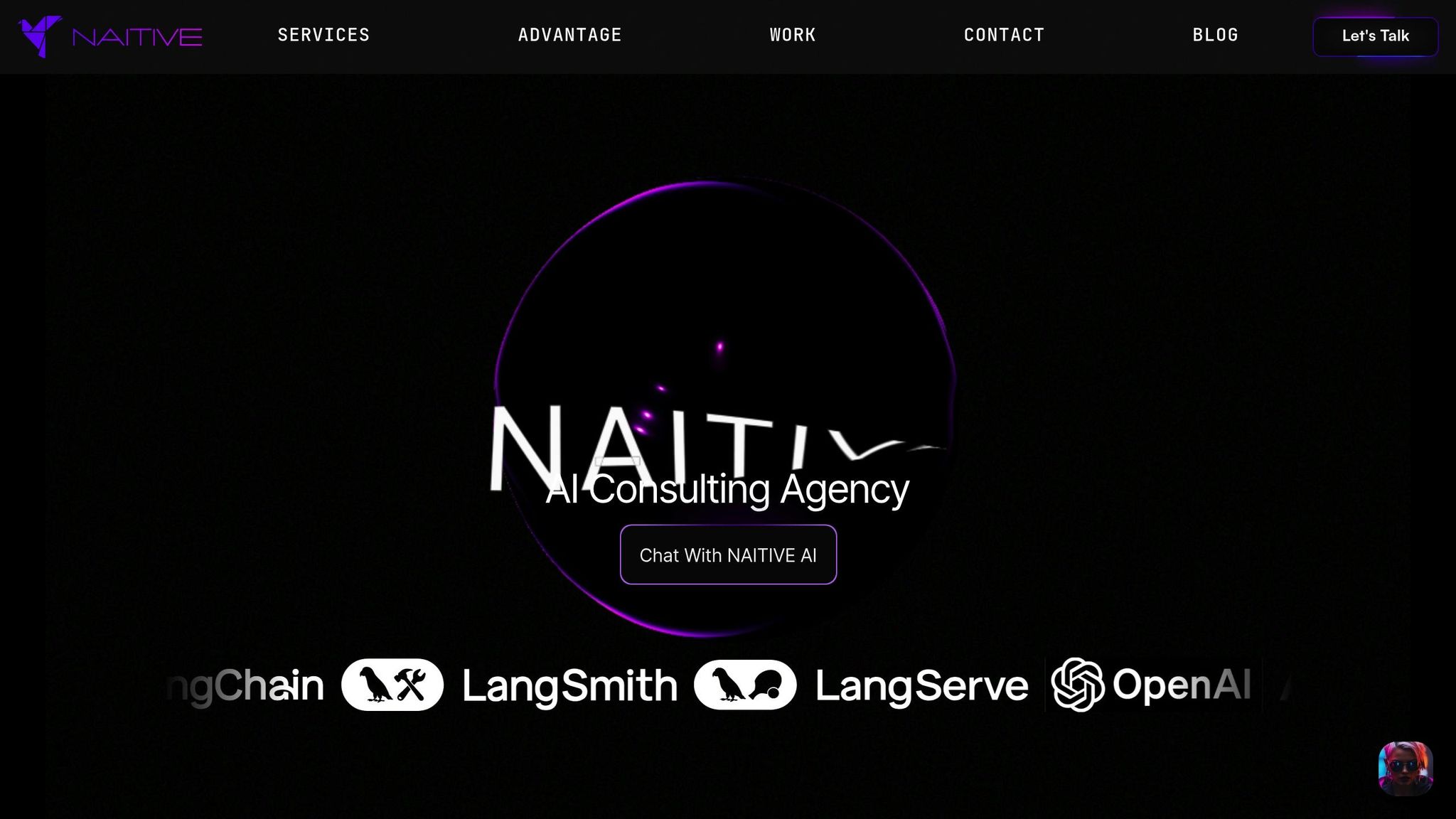Optimizing LLMs for Faster Chatbot Responses
Explore strategies to optimize large language models for faster chatbot responses, enhancing user experience and operational efficiency.

Businesses need faster chatbots to meet user expectations for quick, accurate answers. Optimizing large language models (LLMs) is the key to achieving this, but it requires tackling challenges like computational demands, latency, and maintaining accuracy. Here are the main takeaways:
- Why Speed Matters: Delays frustrate users. Studies show even 100ms latency can impact sales and traffic. Aim for responses under 250ms.
- Challenges: LLMs require heavy computation, which slows responses. Issues like cold start latency and token streaming delays add to the problem.
- Solutions:
- Quantization: Reduces model size for faster processing (e.g., 4-bit models retain accuracy).
- Pruning: Removes unnecessary weights or layers to improve efficiency.
- Parallelization: Distributes tasks across GPUs for quicker results.
- Fine-Tuning: Customizes models for specific tasks, reducing computational load.
- Routing Systems: Direct queries to the most efficient model to save resources.
Techniques like streaming processing, prefix caching, and hardware upgrades (e.g., NVIDIA H100 GPUs) can also cut response times significantly. Businesses using these methods have seen up to a 60% boost in efficiency and better user satisfaction. If you're looking to speed up chatbot interactions, these strategies are essential for staying competitive.
Deep Dive: Optimizing LLM inference
Methods for Faster LLM Inference
Optimizing LLM inference often means tackling computational challenges while preserving accuracy. The techniques below are at the core of improving performance in LLM-based systems.
Quantization Methods for Smaller Models
Quantization reduces the precision of model weights and activations, effectively shrinking model sizes and improving efficiency.
- Post-Training Quantization (PTQ): Applied after training, this method is quicker to implement but may slightly impact accuracy.
- Quantization-Aware Training (QAT): Integrated during training, QAT minimizes accuracy loss but requires more computational effort.
Recent advancements show that models with 4-bit quantization can perform comparably to their full-precision counterparts. Tools like GPTQ can compress models to 3 or 4 bits per parameter while maintaining accuracy, with some even experimenting with extreme quantization down to 2 bits. For instance, BitNet uses 1-bit weights, with BitNet 1.58b allowing weights of 0, -1, or 1, which speeds up computation and enhances efficiency.
Quantization can also be dynamic or static. Dynamic quantization adjusts parameters during inference for better accuracy, while static quantization relies on pre-computed parameters for quicker processing. However, extreme quantization (e.g., 2-bit) requires careful handling of outlier weights. For example, failing to manage outliers caused Qwen-14B-Chat's perplexity score to jump from 7.94 to 140.22 on WikiText.
Pruning Strategies for Lightweight Models
Pruning trims models by removing less critical or redundant weights, making them faster and more memory-efficient.
Key pruning techniques include:
- Weight Pruning: Eliminating weights with minimal impact on outputs.
- Neuron Pruning: Removing inactive neurons or channels.
- Layer Pruning: Cutting out redundant layers.
- Attention Head Pruning: Simplifying transformer models by removing unnecessary attention heads.
Examples highlight pruning's effectiveness. DistilBERT, for instance, retains 97% of BERT's performance with 40% fewer parameters, making it ideal for tasks like text classification. Similarly, TinyLlama lowers the memory and computational demands of the original LLaMA model, making it suitable for mobile and IoT applications. The Minitron approach combines knowledge distillation with pruning, creating compact models for devices with limited resources.
Despite its benefits, pruning must be carefully managed. Over-pruning or targeting the wrong components can harm performance, necessitating thorough analysis and fine-tuning. When paired with hardware parallelization, pruning can significantly streamline inference.
Parallelization and Hardware Optimization
Parallelization and hardware optimization distribute computational tasks across multiple processing units, maximizing efficiency. Techniques like pipeline parallelism, tensor parallelism, and sequence parallelism allow models to scale across GPUs, enabling larger model sizes and faster processing.
For instance, running a batch size of 64 on an NVIDIA A100 GPU boosts throughput by 14× with only moderate latency increases. Upgrading to H100 GPUs has shown even greater gains - Perplexity AI cut latency by 54% and increased throughput by 184%. Additional optimizations like fp8 formats further reduced latency by 49% and improved throughput by 202%.
Other enhancements include:
- Multi-query (MQA) and grouped-query (GQA): Fine-tuning attention mechanisms.
- FlashAttention: Optimizing GPU memory use.
- Mixed precision formats (FP16 or bfloat16): Offering 2×–3× speed improvements with reduced memory usage.
Microsoft's ONNX Runtime optimizations for Llama2 models deliver up to 3.8× faster inference speeds. Meanwhile, AWS's deployment of Llama 2 70B on Inferentia2 instances achieved 42.23 tokens per second with a per-token latency of 88.80 ms. Apple's "Apple Intelligence" model showcases the balance between accuracy and efficiency with a mixed 2-bit and 4-bit configuration, averaging 3.7 bits per weight.
"The trade-off between throughput and latency is driven by the number of concurrent requests and the latency budget, both determined by the application's use case." - Rajvir Singh and Nirmal Kumar Juluru, NVIDIA
Architecture Changes for Better Performance
When it comes to improving chatbot performance, it's not just about refining inference techniques. The underlying architecture plays a huge role, too. Modern large language model (LLM) architectures are moving away from dense designs toward more efficient ones. These newer architectures aim to deliver faster responses while using fewer computational resources, all without compromising on quality. By combining efficient inference methods with smarter architecture, chatbots are becoming quicker and more resource-friendly.
Using Mixture of Experts (MoE) Architectures
Mixture of Experts (MoE) architectures take efficiency to the next level by activating only the parts of a model that are relevant for a specific input. Instead of running the entire model, MoE selectively uses "expert networks", which significantly reduces unnecessary computation.
Take Mixtral 8x7B, for instance. This model uses an eight-expert MoE design but activates only two experts per token. While the model has a total of 46 billion parameters, only 12 billion are active during inference. Similarly, DBRX employs a more fine-grained MoE setup with 132 billion total parameters but activates just 36 billion for any given input. It uses 16 experts per MoE layer, with a gating mechanism selecting 4 experts at a time. In comparison, DBRX is only 40% the size of Grok-1 in both total and active parameters.
Interestingly, Mixtral 8x7B, with its 13 billion active parameters, performs on par with or even surpasses LLaMA-2's 13 billion parameter model on benchmarks like MMLU, HellaSwag, PIQA, and Math. As Cameron R. Wolfe, Ph.D., highlights:
"MoE architectures offer superior tradeoffs between quality and latency compared to dense models."
Another advantage of MoE architectures is their ability to specialize. Each "expert" can focus on specific domains or tasks, making responses more contextually accurate.
Advanced Routing Mechanisms
Advanced routing mechanisms take optimization a step further by ensuring that queries are dynamically directed to the most suitable LLM. This approach minimizes resource usage while maintaining performance.
For example, hybrid routing systems have been shown to cut operational costs by up to 75% while retaining 90% of GPT-4's quality. One study found that advanced routing frameworks could save between 59% and 98% of costs while still delivering accuracy close to larger models. Additionally, similarity-weighted routers have achieved a 22% improvement in Average Performance Gap Recovered (APGR) compared to random routing methods. Hybrid systems can even adjust thresholds dynamically, reducing calls to high-cost models by 22% with only a 1% drop in quality.
Businesses can choose from several routing options, such as LLM-assisted routing for fine-tuned decisions or semantic routing, which uses vector search and embeddings for broader categorization tasks.
Algorithm Optimization Techniques
Algorithmic improvements focus on speeding up the core processes that power LLM inference, helping to reduce delays in chatbot responses.
Streaming processing is a standout method. Instead of waiting for the entire input to be processed, streaming allows models to start working in real time. For example, streaming ASR models handle speech inputs as they come in, and streaming text generation enables chatbots to begin crafting responses immediately. This approach ensures near-instantaneous interaction.
Another clever method is prefix caching, which saves and reuses computations for common prompt prefixes. This has slashed costs by up to 90% for chatbots and translation services. Similarly, smart context compression retrieves only the most relevant parts of long conversation histories using vector search, reducing computational load significantly.
Finally, parallel processing boosts performance by allowing key tasks to run simultaneously. Studies show that user satisfaction drops with delays over 200ms, making sub-500ms response times the ideal target. These techniques ensure faster, smoother interactions, keeping users engaged.
Fine-Tuning and Parameter Optimization for Speed
Once hardware and algorithm updates are in place, fine-tuning and parameter optimization step in to make large language models (LLMs) even faster. These methods help tailor models to specific tasks, reducing the computational load while maintaining high performance.
Task-Specific Fine-Tuning for Efficiency
Fine-tuning hones an LLM’s abilities for particular tasks, streamlining its operations and cutting down on computational demands. For example, Supervised Fine-Tuning (SFT) uses labeled datasets to train models for specific outputs. Meanwhile, Parameter-Efficient Fine-Tuning (PEFT) methods, like LoRA, update only a tiny fraction of the model’s parameters - reducing trainable parameters by up to 10,000 times while retaining performance. Instruction fine-tuning, on the other hand, focuses on improving a model’s ability to follow structured prompts, which is especially useful for chatbots.
In addition, domain-specific fine-tuning molds LLMs for use in particular industries by training them on relevant datasets. This approach can lead to measurable improvements, such as a 10% boost in sentiment analysis accuracy. Embedding domain knowledge directly into the model’s structure allows for quick, informed responses without needing real-time external data retrieval. While fine-tuned models are ideal for specialized purposes, techniques like Retrieval-Augmented Generation (RAG) are better suited for tasks that require up-to-date information.
Best Practices in Parameter Optimization
Fine-tuning is only one part of the equation. Optimizing hyperparameters is equally important for improving both training and inference speed. Key parameters like learning rate and weight decay play critical roles. For example, weight decay not only adjusts the effective learning rate but also impacts both the speed of training and the model’s final performance. Since LLMs often process each training sample just once, getting these settings right from the start is essential.
Batch size is another factor to consider. Larger batches can speed up training but demand more memory. Similarly, gradient clipping helps avoid numerical instability by capping gradient magnitudes, preventing issues that could slow down convergence.
Automated hyperparameter tuning can save a lot of time by systematically searching for the best settings. Techniques like Population-Based Training (PBT) and Bayesian Optimization balance computational effort with outcomes. For instance, a 2017 DeepMind study on PBT showed that a transformer model fine-tuned for English-German translation outperformed a manually tuned baseline. The optimized learning rate started small, increased significantly, and then decayed exponentially. While grid search explores parameters systematically, it can be inefficient for large models, making Bayesian Optimization a more practical choice.
Testing and Performance Evaluation
Once parameters are optimized, thorough testing is essential to ensure these improvements work in actual scenarios. Without proper evaluation, a model’s outputs could erode user trust. As Sumit Soman explains:
"Without proper evaluation, models may generate misleading or low-quality outputs, impacting user trust and real-world applications. Metrics help improve and fine-tuning the model responses."
Performance monitoring tracks key indicators like response time, accuracy, and resource usage, both in terms of functional performance and user experience. Automated evaluation systems offer scalable and objective assessments, but human evaluation is still crucial for catching subtleties that automated tools might miss.
| Performance Indicator | Metric | Application in LLM Evaluation |
|---|---|---|
| Accuracy | Task Success Rate | Measures how often the model provides correct answers to prompts |
| Fluency | Perplexity | Evaluates the natural flow and readability of generated text |
| Relevance | ROUGE Scores | Assesses how well the content aligns with user input |
| Bias | Disparity Analysis | Identifies and mitigates biases in the model’s responses |
| Coherence | Coh-Metrix | Analyzes logical consistency and clarity over extended text |
A combination of offline testing with curated datasets and live monitoring of interactions provides a comprehensive understanding of performance. High-quality data is critical throughout the process - poor input data directly impacts the model’s reliability, as the saying "Garbage In, Garbage Out" reminds us. Automated tools for tracking and alerts help ensure the model continues to perform well as it adapts to evolving usage patterns.
Practical Implementation for Businesses
Key Takeaways for Better Chatbot Performance
Improving the performance of LLM-powered chatbots often comes down to smart optimization strategies. One effective method is model distillation, where smaller models are trained to mirror the performance of larger ones. This approach significantly boosts speed without sacrificing quality. For instance, fine-tuning OpenAI's GPT-4 on a dataset of frequently asked questions has been shown to improve tokens per second (TPS) by about 30%.
Another way to enhance efficiency is by setting output constraints. An e-commerce platform managed to cut processing times by 40% simply by capping product descriptions at 50 words. Similarly, task aggregation - like combining multiple report summaries into a single API request - helped a news organization reduce response times by over 25%.
Upgrading infrastructure is another game-changer. Deploying advanced hardware, such as H100 GPUs, can significantly reduce latency and increase throughput. For businesses looking for quicker wins, semantic caching has proven effective, slashing FAQ response times by 50%.
A step-by-step approach works best. Start with straightforward techniques like reducing model precision using 8-bit quantization. Then, move on to advanced methods such as tensor parallelism and asynchronous processing. As NVIDIA experts Rajvir Singh and Nirmal Kumar Juluru explain:
"The trade-off between throughput and latency is driven by the number of concurrent requests and the latency budget, both determined by the application's use case."
Consistency is crucial for long-term success. Businesses using conversational AI for customer engagement have reported up to a 60% boost in operational efficiency. However, maintaining these gains requires constant attention to areas like data privacy, bias reduction, and performance monitoring. Together, these strategies not only streamline operations but also set the stage for broader, more impactful AI applications.
How NAITIVE AI Can Help Your Business

NAITIVE AI takes these optimization techniques and turns them into actionable, measurable results for businesses. Their process begins with analyzing your operations to pinpoint the most impactful AI opportunities. From there, they design and implement tailored strategies, covering everything from model distillation and fine-tuning to infrastructure scaling and semantic caching.
Unlike basic chatbots that rely on pre-programmed responses, NAITIVE specializes in building autonomous AI agents. These systems go beyond simple interactions, handling complex, multi-step tasks independently. Whether it’s their AI voice agents working around the clock or their autonomous teams automating processes traditionally managed by humans, NAITIVE offers solutions designed to maximize efficiency.
The results speak for themselves: LLM chatbots are now capable of resolving up to 70% of customer queries without human involvement, and businesses leveraging these technologies have seen an average 30% increase in conversion rates. By combining cutting-edge AI tools with a results-driven business strategy, NAITIVE ensures that their solutions deliver real, bottom-line impact.
With their technical expertise and focus on measurable outcomes, NAITIVE is the ideal partner for businesses ready to elevate their AI capabilities beyond basic implementations, unlocking the full potential of transformative AI solutions.
FAQs
What is quantization, and how does it improve the efficiency of large language models without compromising accuracy?
Quantization in Large Language Models
Quantization is a method used to make large language models more efficient by lowering the precision of their weights and activation values. For instance, instead of using high-precision formats like 32-bit floating point, these values are converted into lower-precision formats, such as 8-bit integers. This shift drastically reduces memory requirements and speeds up processing, making it easier to deploy models in real-time scenarios.
The key here is that quantization is designed to maintain the model's accuracy. By carefully managing the conversion process to minimize information loss, it ensures the model performs almost as well as before, all while requiring less computational power.
How do Mixture of Experts (MoE) architectures improve chatbot performance compared to traditional dense models?
Mixture of Experts (MoE) architectures enhance chatbot performance by delivering quicker response times, improved scalability, and more efficient resource allocation. Unlike traditional dense models that activate every parameter for each input, MoE models activate only a targeted subset of specialized "experts" based on the input's requirements. This selective activation significantly reduces computational strain, making it easier for the model to tackle large-scale tasks without overloading hardware.
By directing computational resources to where they're needed most, MoE architectures can scale up to trillions of parameters while staying efficient. This design is especially beneficial for conversational AI systems, where speed and accuracy are critical to providing a smooth and engaging user experience.
What are the best ways to implement advanced routing to make chatbot systems faster and more cost-efficient?
To make chatbot systems work smarter and faster, businesses can tap into advanced routing techniques like semantic routing. This method pairs users with the most fitting AI or human agents by analyzing the context and intent behind their queries. The result? Quicker, more precise responses that leave users satisfied.
Another game-changing tactic is dynamic task assignment powered by large language models (LLMs). This strategy streamlines operations by directing tasks to the most appropriate models or agents, cutting down on unnecessary processing. In fact, it can slash operational costs by up to 75% - all without compromising the quality of responses.
By integrating these methods, companies can boost the speed, efficiency, and cost savings of their chatbot systems, delivering better experiences for users while achieving stronger operational results.




